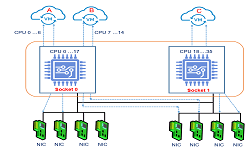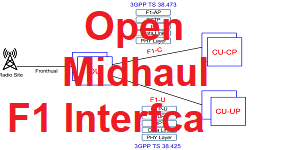5G RIC – RAN Intelligent Controller
With the evolution and advancements in 4G & 5G RAN architecture e.g. CUPS, Layer Function split concept and virtualization, made it possible to use SDN concepts into the mobile infrastructure.
SDN enables possibilities to combine the capabilities in order to enable configuration, optimization and control from centralized location or aggregation points for the underlying RAN infrastructure. This way now 4G eNB or 5G gNB functionalities like mobility management, admission control, interference management can be exposed as Software Apps to be available at northbound interface.
The Software Apps can be used as plug-ins with the help RAN controller, and their policies can be enforced via southbound interface towards eNB/gNB. Such architecture enables unprecedented means for controlling radio resources in comprehensive way.
So we can say that RAN Intelligent Control aka RIC is a suite of Software Apps to enable SDN functionalities in open RAN networks.
RIC is basically responsible for all RAN operation and optimization procedure like radio connection management, mobility management, QoS management, edge services, and interference management, radio resource management, higher layer procedure optimization, policy optimization in RAN, and providing guidance, parameters, policies and AI/ML models to support the best effective network operation.
Types of RAN Intelligent Controller (RIC)
As per the Open RAN architecture, there are following two types of RAN Intelligent Controller. This classification of RIC is done based on control functionality timings e.g. Non-RT control functionality (> 1s) and near-Real Time (near-RT) control functions(<1s).
- Non Real-Time RIC (RIC non-RT)
- Near Real-Time RIC (RIC near-RT)

Requirements for RAN Controller:
- Unified Nature to support all “G” (2G, 3G, 4G, 5G)
- No Vendor Lock-in, must support OpenRAN compliant interfaces
- Must support Network automation for easy and fast deployment
- Support Cloud-Native Deployments
- Support easy integration of open Source AI & ML
Non Real-Time RIC (RIC non-RT)
Non-RT functions include service and policy management, RAN analytics and model-training for the near-RT RAN functionality. Trained models and real-time control functions produced in the RIC non-RT are distributed to the RIC near-RT for runtime execution.
RIC Non-RT has following functions includes
- O-RAN specification defined an A1 interface between Orchestration/NMS layer with RIC non-RT and eNB/gNB containing RIC near-RT.
- Network management applications in non-RT RIC receives and act on highly reliable data from the modular Control Unit (CU) and Distributed Unit (DU) in a standardized format over A1 Interface.
- AI-enabled policies and ML-based models generated messages in RIC non-RT and conveyed to RIC near-RT.
- The core algorithm of non-RT RIC is owned and deployed by network operators
- This algorithms provides the capability to modify the RAN behaviors based by deployment of different models optimized to individual operator policies and optimization objectives
Near Real-Time RIC (RIC Near-RT)
The O-RAN reference architecture provides next generation RRM with embedded intelligence,while optionally accommodating legacy RRM. This resides within the RIC Near RT function layer. The RIC near-RT is completely compatible with legacy RRM and its design is started to enhancing the operational challenging functions such as per-UE controlled load-balancing, RB management, interference detection and mitigation.
RIC Near-RT has following functions includes
- It provides new functions leveraging embedded intelligence,such as QoS management, connectivity management and seamless handover control.
- The RIC near-RT delivers a robust, secure, and scalable platform that allows for flexible on-boarding of third-party control-applications.
- RIC near-RT functions leverages a database called the Radio-Network Information Base (R-NIB) which captures the near real-time state of the underlying network
- It feeds various RAN measurements data, to the near-RT RIC to facilitate radio resource management
- It also provides initiate configuration commands to CU/DU.
- The near-RT RIC can be provided by traditional TEMs or 3rd-party players
- RIC near-RT receives an AI model from RIC non-RT and execute it to change the functional behavior of the network
- Interface Reference Points (A1 & E2)
- A1, as described above, is the interface between non-RT RIC and modular CU which contains near-RT RIC.
- E2 is a standard interface between the near-RT RIC and CU/DU in the context of an O-RAN architecture.
How it works:
Large amount of data, counters, statistics, failure information are available with L1/L2/L3 protocols stack of eNB/gNB (including CU/DU) which be collected and used for data features and models can be learned or abstracted to empower intelligent management and control the RAN using Data Analytics/Artificial Intelligence (AI)/Machine Learning (ML). Some of the example models includes, network spatial-temporal traffic patterns, user mobility patterns, service type/patterns along with the corresponding prediction, network quality of service (QoS) prediction patterns, massive MIMO parameters configuration, and more can be reused, abstracted or learned.
This abstracted or learned information can then be combined with additional network-wide context and policies can be framed to drive fine-grained network operations i.e. radio resource management, load-balancing, ID allocations, handover decisions, etc.
The core algorithms used by AI/ML can be developed and owned by network service provider (operators), some aspects of which may be proprietary. This provides the capability to modify the RAN behaviors by deploying different policies and models optimized to individual operator intents and objectives.
RAN Intelligent Controller Products
Surfing through web, we could find out RAN Intelligent Controller product from following vendors.
Related Post
- Open RAN (O-RAN) Reference Architecture
- 5G NR gNB Logical Architecture and Its Functional Splits
- 5G NR gNB High Layer Split
- Control and User Plane Separation for Next Generation EPC
- Hybrid Core Network – 4G Core to 5 G Core Interconnection



